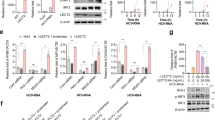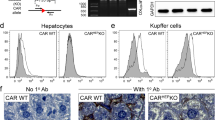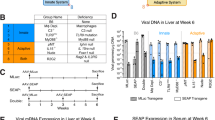Abstract
The complement system is known to play critical roles in pathogen identification, initiation of innate immune responses and facilitation of adaptive immune responses. Several studies have suggested that recombinant adenoviruses (rAds) interact with proteins of the complement system within minutes of administration. In this study, we assessed the roles of the alternative (Factor B), classical (C1q and C4) and common (C3) arms of the complement system in the innate and humoral response to systemic rAd administration using mice genetically deficient for each of these functions. Although most plasma cytokines and chemokines induced by Ads appeared to be elicited in a C3-dependent manner, we found that rAd-induced thrombocytopenia was dependent on Factor B and C3, implicating the alternative pathway as responsible for this response. Alteration of the complement-dependent transcriptome response after rAd-induced liver gene expression was also found to be Factor B- and C3-dependent. Ad interactions with the classical and alternative arms of the complement system can also be redundant, as many complement-dependent, Ad-induced innate immune responses appeared to be primarily C3-dependent. We also identified a C3 dependence of Ad-mediated induction of the nuclear factor-κB (NF-κB) activation pathway. Finally, we confirmed that humoral immune responses to the vector capsid, and the transgene it encodes, are also complement-dependent.
This is a preview of subscription content, access via your institution
Access options
Subscribe to this journal
Receive 12 print issues and online access
$259.00 per year
only $21.58 per issue
Buy this article
- Purchase on Springer Link
- Instant access to full article PDF
Prices may be subject to local taxes which are calculated during checkout






Similar content being viewed by others
References
Wu L, Kong WP, Nabel GJ . Enhanced breadth of CD4 T-cell immunity by DNA prime and adenovirus boost immunization to human immunodeficiency virus Env and Gag immunogens. J Virol 2005; 79: 8024–8031.
Sullivan NJ, Sanchez A, Rollin PE, Yang ZY, Nabel GJ . Development of a preventive vaccine for Ebola virus infection in primates. Nature 2000; 408: 605–609.
Catanzaro AT, Koup RA, Roederer M, Bailer RT, Enama ME, Moodie Z et al. Phase 1 safety and immunogenicity evaluation of a multiclade HIV-1 candidate vaccine delivered by a replication-defective recombinant adenovirus vector. J Infect Dis 2006; 194: 1638–1649.
Gao W, Soloff AC, Lu X, Montecalvo A, Nguyen DC, Matsuoka Y et al. Protection of mice and poultry from lethal H5N1 avian influenza virus through adenovirus-based immunization. J Virol 2006; 80: 1959–1964.
Molinier-Frenkel V, Gahery-Segard H, Mehtali M, Le Boulaire C, Ribault S, Boulanger P et al. Immune response to recombinant adenovirus in humans: capsid components from viral input are targets for vector-specific cytotoxic T lymphocytes. J Virol 2000; 74: 7678–7682.
Caetano BC, Bruna-Romero O, Fux B, Mendes EA, Penido ML, Gazzinelli RT . Vaccination with replication-deficient recombinant adenoviruses encoding the main surface antigens of Toxoplasma gondii induces immune response and protection against infection in mice. Hum Gene Ther 2006; 17: 415–426.
Appledorn DM, Patial S, McBride A, Godbehere S, Van Rooijen N, Parameswaran N et al. Adenovirus vector induced innate inflammatory mediators, MAPK signaling, as well as adaptive immune responses are dependent upon both TLR2 and TLR9 in vivo. J Immunol 2008 (in press).
Cichon G, Boeckh-Herwig S, Schmidt HH, Wehnes E, Muller T, Pring-Akerblom P et al. Complement activation by recombinant adenoviruses. Gene Therapy 2001; 8: 1794–1800.
Hartman ZC, Black EP, Amalfitano A . Adenoviral infection induces a multi-faceted innate cellular immune response that is mediated by the Toll-like receptor pathway in A549 cells. Virology 2007; 358: 357–372.
Hartman ZC, Kiang A, Everett RS, Serra D, Yang XY, Clay TM et al. Adenovirus infection triggers a rapid, MyD88-regulated transcriptome response critical to acute-phase and adaptive immune responses in vivo. J Virol 2007; 81: 1796–1812.
Jiang H, Wang Z, Serra D, Frank MM, Amalfitano A . Recombinant adenovirus vectors activate the alternative complement pathway, leading to the binding of human complement protein C3 independent of anti-ad antibodies. Mol Ther 2004; 10: 1140–1142.
Kiang A, Hartman ZC, Everett RS, Serra D, Jiang H, Frank MM et al. Multiple innate inflammatory responses induced after systemic adenovirus vector delivery depend on a functional complement system. Mol Ther 2006; 14: 588–598.
Barrington R, Zhang M, Fischer M, Carroll MC . The role of complement in inflammation and adaptive immunity. Immunol Rev 2001; 180: 5–15.
Frank MM, Fries LF . The role of complement in inflammation and phagocytosis. Immunol Today 1991; 12: 322–326.
Petersen SV, Thiel S, Jensenius JC . The mannan-binding lectin pathway of complement activation: biology and disease association. Mol Immunol 2001; 38: 133–149.
Kemper C, Atkinson JP . T-cell regulation: with complements from innate immunity. Nat Rev 2007; 7: 9–18.
Carroll MC . The complement system in regulation of adaptive immunity. Nat Immunol 2004; 5: 981–986.
Kiang A, Hartman ZC, Liao S, Xu F, Serra D, Palmer DJ et al. Fully deleted adenovirus persistently expressing GAA accomplishes long-term skeletal muscle glycogen correction in tolerant and nontolerant GSD-II mice. Mol Ther 2006; 13: 127–134.
Appledorn DM, Kiang A, McBride A, Jiang H, Seregin S, Scott JM et al. Wild-type adenoviruses from groups A-F evoke unique innate immune responses, of which HAd3 and SAd23 are partially complement dependent. Gene Therapy 2008; 15: 885–901.
Lieber A, He CY, Meuse L, Schowalter D, Kirillova I, Winther B et al. The role of Kupffer cell activation and viral gene expression in early liver toxicity after infusion of recombinant adenovirus vectors. J Virol 1997; 71: 8798–8807.
Tibbles LA, Spurrell JC, Bowen GP, Liu Q, Lam M, Zaiss AK et al. Activation of p38 and ERK signaling during adenovirus vector cell entry lead to expression of the C–X–C chemokine IP-10. J Virol 2002; 76: 1559–1568.
Zhang Y, Chirmule N, Gao GP, Qian R, Croyle M, Joshi B et al. Acute cytokine response to systemic adenoviral vectors in mice is mediated by dendritic cells and macrophages. Mol Ther 2001; 3: 697–707.
Kalyuzhniy O, Di Paolo NC, Silvestry M, Hofherr SE, Barry MA, Stewart PL et al. Adenovirus serotype 5 hexon is critical for virus infection of hepatocytes in vivo. Proc Natl Acad Sci USA 2008; 105: 5483–5488.
Parker AL, Waddington SN, Nicol CG, Shayakhmetov DM, Buckley SM, Denby L et al. Multiple vitamin K-dependent coagulation zymogens promote adenovirus-mediated gene delivery to hepatocytes. Blood 2006; 108: 2554–2561.
Shayakhmetov DM, Gaggar A, Ni S, Li ZY, Lieber A . Adenovirus binding to blood factors results in liver cell infection and hepatotoxicity. J Virol 2005; 79: 7478–7491.
Waddington SN, McVey JH, Bhella D, Parker AL, Barker K, Atoda H et al. Adenovirus serotype 5 hexon mediates liver gene transfer. Cell 2008; 132: 397–409.
Manickan E, Smith JS, Tian J, Eggerman TL, Lozier JN, Muller J et al. Rapid Kupffer cell death after intravenous injection of adenovirus vectors. Mol Ther 2006; 13: 108–117.
Wolins N, Lozier J, Eggerman TL, Jones E, Aguilar-Cordova E, Vostal JG . Intravenous administration of replication-incompetent adenovirus to rhesus monkeys induces thrombocytopenia by increasing in vivo platelet clearance. Br J Haematol 2003; 123: 903–905.
Cerullo V, Seiler MP, Mane V, Brunetti-Pierri N, Clarke C, Bertin TK et al. Toll-like receptor 9 triggers an innate immune response to helper-dependent adenoviral vectors. Mol Ther 2007; 15: 378–385.
Zhu J, Huang X, Yang Y . Innate immune response to adenoviral vectors is mediated by both Toll-like receptor-dependent and -independent pathways. J Virol 2007; 81: 3170–3180.
Muruve DA . The innate immune response to adenovirus vectors. Hum Gene Ther 2004; 15: 1157–1166.
Muruve DA, Barnes MJ, Stillman IE, Libermann TA . Adenoviral gene therapy leads to rapid induction of multiple chemokines and acute neutrophil-dependent hepatic injury in vivo. Hum Gene Ther 1999; 10: 965–976.
Hawlisch H, Kohl J . Complement and Toll-like receptors: key regulators of adaptive immune responses. Mol Immunol 2006; 43: 13–21.
Zhang X, Kimura Y, Fang C, Zhou L, Sfyroera G, Lambris JD et al. Regulation of Toll-like receptor-mediated inflammatory response by complement in vivo. Blood 2007; 110: 228–236.
Helmy KY, Katschke Jr KJ, Gorgani NN, Kljavin NM, Elliott JM, Diehl L et al. CRIg: a macrophage complement receptor required for phagocytosis of circulating pathogens. Cell 2006; 124: 915–927.
Wiesmann C, Katschke KJ, Yin J, Helmy KY, Steffek M, Fairbrother WJ et al. Structure of C3b in complex with CRIg gives insights into regulation of complement activation. Nature 2006; 444: 217–220.
Mehlhop E, Diamond MS . Protective immune responses against West Nile virus are primed by distinct complement activation pathways. J Exp Med 2006; 203: 1371–1381.
Zaiss AK, Cotter MJ, White LR, Clark SA, Wong NC, Holers VM et al. Complement is an essential component of the immune response to adeno-associated virus vectors. J Virol 2008; 82: 2727–2740.
Ferreira DM, Darrieux M, Oliveira ML, Leite LC, Miyaji EN . Optimized immune response elicited by a DNA vaccine expressing pneumococcal surface protein a is characterized by a balanced immunoglobulin G1 (IgG1)/IgG2a ratio and proinflammatory cytokine production. Clin Vaccine Immunol 2008; 15: 499–505.
Hodges BL, Evans HK, Everett RS, Ding EY, Serra D, Amalfitano A . Adenovirus vectors with the 100 K gene deleted and their potential for multiple gene therapy applications. J Virol 2001; 75: 5913–5920.
Ng P, Graham FL . Construction of first-generation adenoviral vectors. Methods Mol Med 2002; 69: 389–414.
Amalfitano A, Hauser MA, Hu H, Serra D, Begy CR, Chamberlain JS . Production and characterization of improved adenovirus vectors with the E1, E2b, and E3 genes deleted. J Virol 1998; 72: 926–933.
Everett RS, Hodges BL, Ding EY, Xu F, Serra D, Amalfitano A . Liver toxicities typically induced by first-generation adenoviral vectors can be reduced by use of E1, E2b-deleted adenoviral vectors. Hum Gene Ther 2003; 14: 1715–1726.
Hu H, Serra D, Amalfitano A . Persistence of an [E1-, polymerase-] adenovirus vector despite transduction of a neoantigen into immune-competent mice. Hum Gene Ther 1999; 10: 355–364.
Hofstetter JR, Zhang A, Mayeda AR, Guscar T, Nurnberger Jr JI, Lahiri DK . Genomic DNA from mice: a comparison of recovery methods and tissue sources. Biochem Mol Med 1997; 62: 197–202.
Loniewski KJ, Patial S, Parameswaran N . Sensitivity of TLR4- and -7-induced NF kappa B1 p105-TPL2-ERK pathway to TNF-receptor-associated-factor-6 revealed by RNAi in mouse macrophages. Mol Immunol 2007; 44: 3715–3723.
Parameswaran N, Pao CS, Leonhard KS, Kang DS, Kratz M, Ley SC et al. Arrestin-2 and G protein-coupled receptor kinase 5 interact with NFkappaB1 p105 and negatively regulate lipopolysaccharide-stimulated ERK1/2 activation in macrophages. J Biol Chem 2006; 281: 34159–34170.
Hensley SE, Cun AS, Giles-Davis W, Li Y, Xiang Z, Lasaro MO et al. Type I interferon inhibits antibody responses induced by a chimpanzee adenovirus vector. Mol Ther 2007; 15: 393–403.
Acknowledgements
We thank Z Hartman, A Sisk, D Serra, K Porter, S Patial and N Parameswaran for technical support, and both the Duke University and Michigan State University Laboratory Animal support facilities for their assistance in the humane care and maintenance of the animals used in this work. AA was supported by the National Institutes of Health Grants RO1DK-069884 and P01 CA078673, as well as by the Osteopathic Heritage Foundation.
Author information
Authors and Affiliations
Corresponding author
Additional information
Supplementary Information accompanies the paper on Gene Therapy website (http://www.nature.com/gt)
Supplementary information
Rights and permissions
About this article
Cite this article
Appledorn, D., McBride, A., Seregin, S. et al. Complex interactions with several arms of the complement system dictate innate and humoral immunity to adenoviral vectors. Gene Ther 15, 1606–1617 (2008). https://doi.org/10.1038/gt.2008.114
Received:
Revised:
Accepted:
Published:
Issue Date:
DOI: https://doi.org/10.1038/gt.2008.114
Keywords
This article is cited by
-
Strengthened tumor antigen immune recognition by inclusion of a recombinant Eimeria antigen in therapeutic cancer vaccination
Cancer Immunology, Immunotherapy (2015)
-
Improved cytotoxic T-lymphocyte immune responses to a tumor antigen by vaccines co-expressing the SLAM-associated adaptor EAT-2
Cancer Gene Therapy (2013)
-
FX and Host Defense Evasion Tactics by Adenovirus
Molecular Therapy (2013)
-
Immunogenicity when utilizing adenovirus serotype 4 and 5 vaccines expressing circumsporozoite protein in naïve and Adenovirus (Ad5) immune mice
Malaria Journal (2012)
-
An ex vivo loop system models the toxicity and efficacy of PEGylated and unmodified adenovirus serotype 5 in whole human blood
Gene Therapy (2010)



